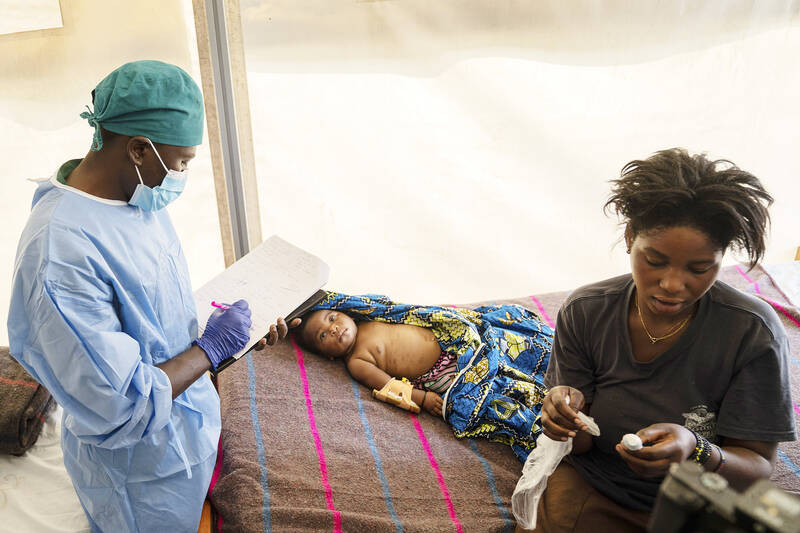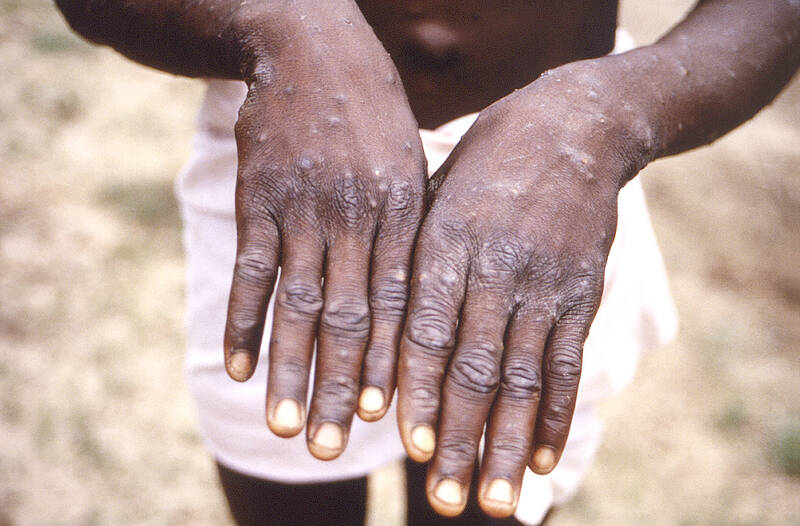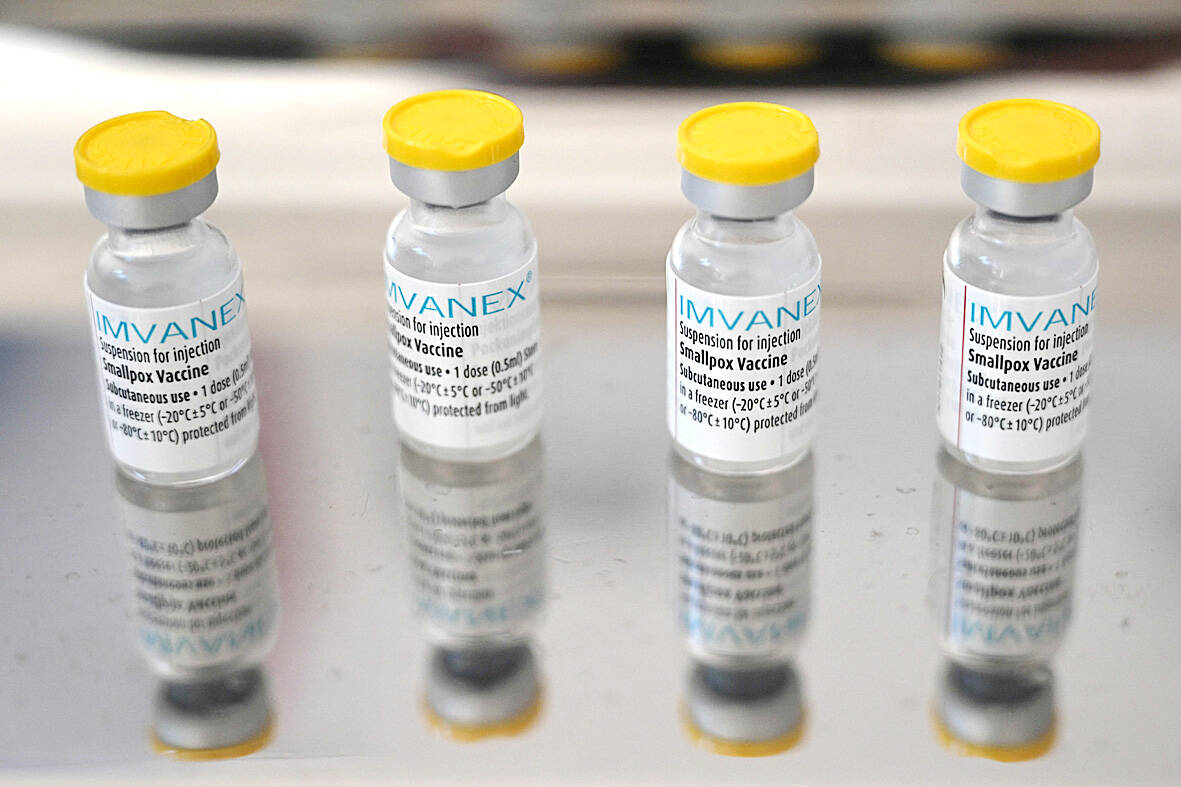The World Health Organization (WHO) has declared that an outbreak of mpox, a viral infection that spreads through close contact, represents a global health emergency for the second time in two years.
WHAT IS MPOX?
Mpox is a viral infection that causes flu-like symptoms and pus-filled lesions, and while usually mild, it can kill. Children, pregnant women and people with weakened immune systems, such as those with HIV, are all at higher risk of complications.

Photo: AP 照片:美聯社
The WHO declared the recent outbreak of the disease a public health emergency after a new offshoot of the mpox virus, first identified in Democratic Republic of Congo, began spreading to other neighboring countries.
Mpox transmits through close physical contact, including sexual contact, but there is no evidence that it spreads easily through the air.
The new offshoot has caused global alarm because it appears to spread more easily between people.

Photo: AP 照片:美聯社
WHAT IS A GLOBAL HEALTH EMERGENCY?
A “public health emergency of international concern”, or PHEIC, is the WHO’s highest form of alert. It is announced when diseases are spreading in new or unusual ways, and is aimed at galvanizing international co-operation and funding to tackle an outbreak.
WHY IS MPOX AN EMERGENCY AGAIN?

Photo: AFP 照片:法新社
Two years ago, the WHO declared mpox was an emergency when a form of the disease, clade IIb, began to spread globally, largely among men who have sex with men.
That outbreak was brought under control after behavior change and safe sex practices, plus vaccines, helped people at risk protect themselves in many countries.
But mpox has been a public health problem in parts of Africa for decades. The first ever human case was in Congo in 1970, and it has had outbreaks ever since.
The current outbreak, Congo’s worst ever, has seen 27,000 cases and more than 1,100 deaths since January 2023, largely among children.
WHAT HAPPENS NOW?
Scientists hope that the emergency declarations will speed up efforts to get more medical tools and funding to Congo to help the authorities there tackle the outbreak. Better surveillance is needed to study the virus and help stop the spread.
But in 2022, a WHO appeal for US$34 million to fight mpox got no take-up from donors, and there was huge inequity in who had access to vaccine doses. African countries had no access to the two shots used in the global outbreak, made by Bavarian Nordic and KM Biologics.
However, mpox is not COVID-19. There are tools that are proven to work to stop the spread and help those at risk, and it does not spread as easily.
The challenge now, which the emergency declarations aim to highlight, is making sure those tools reach those who need them most, in Congo and neighboring countries.
(Reuters)
世界衛生組織宣布,M痘(一種透過密切接觸傳播的病毒感染,舊稱猴痘)疫情之爆發為全球衛生緊急事件。這是M痘兩年內第二次成為全球衛生緊急事件。
什麼是M痘?
M痘是一種病毒感染,會引起類似流感的症狀和化膿的病變,雖然症狀通常輕微,但也可能致命。兒童、孕婦和免疫系統較弱的人(例如愛滋病毒帶原者)出現併發症的風險較高。
一株在剛果民主共和國首次發現的M痘病毒新變種開始傳播到鄰國後,世衛組織將最近爆發的這波M痘疫情公告為公共衛生緊急事件。
M痘透過密切的身體接觸(包括性接觸)傳播,但並無證據顯示它容易透過空氣傳播。
這新的變種引起了全球恐慌,因為它似乎更容易在人與人之間傳播。
全球衛生緊急事件是什麼?
「國際關注公共衛生緊急事件」(PHEIC)是世衛組織的最高警報形式。當疾病以新的或不尋常的方式傳播時,世衛就會做此公告,旨在促使國際合作、挹注資金來應對疫情。
M痘為何再度成為緊急事件?
兩年前,世界衛生組織宣布M痘為緊急事件,當時M痘的一個分支IIb型開始在全球傳播,主要在男男性行為者中傳播。
透過改變做法、安全性行為,再加上幫助高風險族群自我保護的疫苗,疫情在許多國家得到了控制。
但數十年來,M痘一直是非洲部分地區的公共衛生問題。第一個人類病例於1970年在剛果出現,此後M痘持續傳出疫情。
目前的疫情是在剛果最嚴重的一次,自2023年1月以來已有兩萬七千個病例,一千一百多人死亡,其中大部分是兒童。
目前情況如何?
科學家希望宣布M痘為緊急事件能使更多醫療工具和資金加快挹注剛果,以幫助當地政府應對疫情。要研究病毒並阻止其傳播,必須加強監測。
但在2022年,世衛呼籲提供三千四百萬美元來對抗M痘,但捐款不足,且疫苗的獲取有巨大不平等。全球疫情中所使用的兩種疫苗——分別由丹麥巴伐利亞北歐公司(Bavarian Nordic)及日本KM生技公司(KM Biologics)所製造——非洲國家無法取得。
然而,M痘並非COVID-19。有些工具證明可有效阻止病毒傳播並幫助高風險族群,且病毒並不像COVID-19那樣容易傳播。
宣布M痘為緊急事件旨在強調,當前的挑戰是確保這些工具能夠送達剛果及其鄰國最需要的人手中。
(台北時報林俐凱編譯)